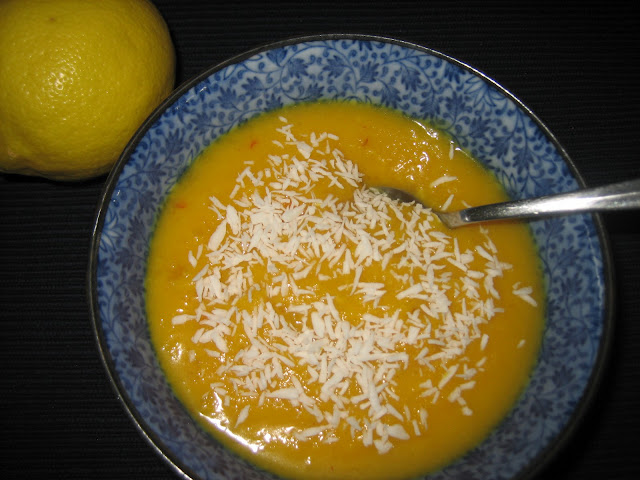 |
| Spicy Butternut Squash Coconut Soup |
Just when I thought I had exhausted all of the possible butternut squash soup recipes, I found another one that I tweaked to fit my needs and tastes, and wowza! It all started so innocently. A local store was selling peeled, seeded, and cubed butternut squash. The thought of not needing to prep the squash was insanely appealing to me. Preparing my food requires most of my energy some days, and any step that can make it easier is worth it for me.
The original recipe is from Soup Bible (Penguin Books, 2007) and included coconut cream as an ingredient. My friend's mother has used coconut cream and coconut oil consistently for decades and when she learned a couple of years ago that coconut oil was recommended to me as a highly digestible fat, she shared a jar of her coconut cream concentrate with me. (I know, I know...I still haven't made a post about the merits of coconut oil for people with pancreatic insufficiency. I promise to get to that soon.) I have enjoyed coconut cream just as a spread on toast, but had never tried it in a recipe, so was glad to find this squash soup recipe. Absolutely delicious!!! Since the product that I had was coconut cream concentrate, I adjusted the recipe accordingly. Also, the original recipe used sweet chili sauce and I used Thai style chili sauce since that was what I had in the refrigerator. I'm not sure how sweet chili sauce is different than the Thai style chili sauce that I used, but the pairing with the squash was extraordinary. What was even more extraordinary was the realization that this soup has a whopping 21 grams of fat per serving, but because it is coconut fat, I digested it without a problem. What a treat to enjoy something so creamy and decadent. Of course, if you don't need to use coconut oil as I do, you could certainly substitute something like regular cream or similar for it. Pzazz means having fun with the challenges each of us encounter!
Ingredients:
1 Tablespoon olive oil
 1 large onion, finely chopped
1 large onion, finely chopped2 cloves garlic, crushed
1 Tablespoon finely grated fresh ginger
1/2 teaspoon ground turmeric
1 pound peeled, seeded, and cubed butternut squash
3 cups low-sodium chicken stock
3 teaspoons coconut cream concentrate
(or 1/4 cup coconut cream)
1 Tablespoon Thai style chili sauce (or sweet chili sauce)
1 teaspoon finely grated lemon zest
salt and freshly ground black pepper
1 Tablespoon finely shredded unsweetened coconut
Preparation:
Heat oil in a large saucepan over a low heat and add onion, garlic, ginger, turmeric and squash. Cook for 4 -5 minutes, then add broth and bring to a boil. Simmer, covered for 20 - 30 minutes until the squash is tender. Remove from heat and cool a little.
Puree the soup until smooth with an immersion blender or in a regular blender. Return to the stove and gently reheat. Stir in the coconut cream concentrate, chili sauce and lemon zest. Season to taste with the salt and pepper. Ladle into bowls and garnish with shredded coconut.

Nutrition:
Servings per recipe: 4
Serving Size: About 3/4 cup
Calories: 161
Total Fat: 21 g
Cholesterol: 0 mg
Sodium: 91 mg
Total Carbs: 20 g
Dietary Fiber: 5 g
Protein:4 g























